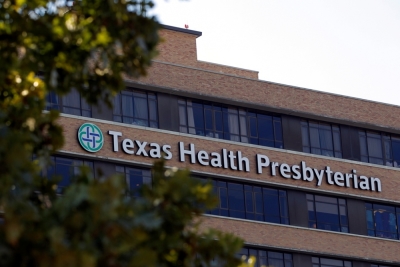Will U.S. Keep Ebola In Check Here at Home?

Some 3,000 American soldiers are arriving in Africa to fight an Ebola epidemic that is doubling about every 3 weeks, with the number of infections projected to reach 1.4 million by January. President Obama said: "It will require an 'air bridge' to get health workers and medical supplies to areas that are affected."
Meanwhile, the virus has used the air bridge of a commercial flight to reach Dallas. So far, only the index patient is ill, but 100 contacts are being observed.
Although a large number of experts agree that the likelihood of a widespread outbreak is "vanishingly small," owing to our "highly sophisticated public health system," a number of breaches in our invulnerability are already manifest.
- The hospital where the patient initially presented failed to follow federal guidelines. He told a nurse that he had been in Liberia and should have been placed in isolation and tested for Ebola immediately. Instead, he was sent home on antibiotics, which are useless for viral infections.
- The patient vomited copiously outside his apartment before returning to the hospital by ambulance. No precautions were taken in cleaning up.
- The ambulance was kept in service with no special disinfecting, and the crews were not informed.
- Even now, the patient is being treated under BSL-2 (biosafety level 2) conditions, although the World Health Organization states that BSL-4 precautions are needed for working with Ebola virus.
- Rules requiring international passengers to fill out a detailed health questionnaire have not been implemented, although the CDC called them "critical to protecting Americans from dangerous diseases spread by travelers"—in 2006.
Officials are frequently reassuring people that the virus is not "airborne" and that "direct contact" with a sick person is required to get infected. It is not possible, we are told, to get Ebola from a person who does not have symptoms. We just need hand washing and other "simple, basic precautions."
Meanwhile, CDC officials are in full hazmat gear, and some say that you need a buddy to make sure that every square millimeter of your skin is covered at all times. A tiny pinprick through your glove, and you've got Ebola.
The official website of the Public Health Agency of Canada stated, "airborne spread among humans is strongly suspected, although it has not yet been conclusively demonstrated." Then, sometime between Oct 1 and Oct 2 the Agency actually changed the language of their Pathogen Safety Data Sheet on Ebola to softer, less alarming language on airborne transmission, including the removal of citations to key scientific literature.
It would be quite remarkable for body fluids like vomitus or saliva to be infectious while on the patient, or after landing on a surface (where they may remain infectious for days), but not while aerosolized between the patient and their landing place. Cells in the skin and mucous membranes contain receptors targeted by the virus.
And how can one be sure that an asymptomatic patient cannot transmit disease? The virus is multiplying in his body—what is to prevent it from being shed before he notices fever or headache? It's a matter of degree. Corpses are teeming with virus, but it only takes a very few particles to infect someone.
Understandably, public health officials do not wish to cause a panic, as panic itself can cause countless casualties. But absolute statements that prove to be false will destroy the credibility of the authorities.
The potential for devastating loss of life is real. The disease must be stopped before there are millions of persons exposed instead of 100. These precautions are clearly needed now:
- Restricted entry: Travelers from affected areas need to be carefully screened and quarantined when indicated.
- A high index of suspicion: a travel and exposure history are essential in any patients with fever and symptoms that could be Ebola (headache, muscle pains, prostration, nausea and vomiting, a spotty rash).
- Precautionary isolation: When Ebola is a possibility, patients need to be tested and isolated until results are known to be negative.
- Meticulous contact tracing: At-risk persons need to be identified, notified, monitored, and isolated as needed.
- Preparedness: Hospitals need to train all personnel, assure adequate supplies of protective gear, assure that their housekeeping is fastidious, and have a high level of alertness.
Disease has defeated mighty armies and brought down empires before. The U.S. is not immune. We need hardheaded realism, not complacent reassurance.





























